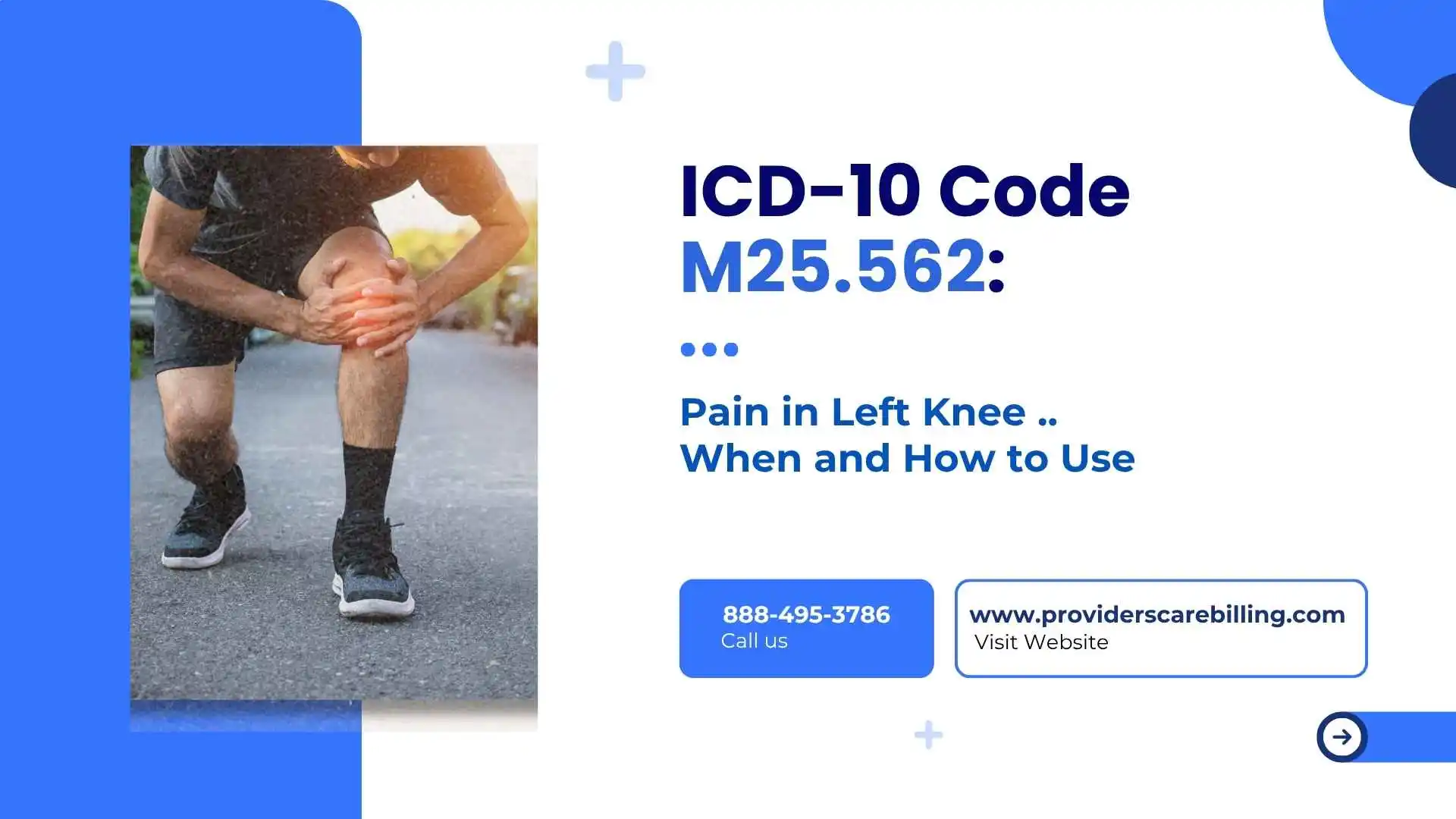Knee pain is one of the confirmed common musculoskeletal complaints acknowledged in the U.S, specifically, in people aged above 40 years.
A proper diagnosis and code (using the ICD-10 M25.562) of discomfort in the left knee is absolutely necessary in treatment as well as reimbursement, and may be because of the cause, be it an acute injury, osteoarthritis, or an overuse issue. The fact is that the wrong codes or no documentation can cause delays, denials, or even an audit, which is detrimental to your pocket and to your patients who want to get knee replacement facilities.
A 35-year-old marathon runner who has been complaining of chronic discomfort in her left knee gets seen by a sports medicine specialist in Texas. Clinical notes on pain during jogging, limited motion, and swelling are included in her chart. Mild osteoarthritis and tendon irritation are seen on MRI. The insurance paid for diagnostics and physical therapy thanks to proper coding using M25.562, M17.12, and CPT codes for imaging and evaluation, ensuring accurate diagnosis.
What Does Knee Pain Mean?
Pain in the knee is a common concern among individuals of all ages. Knee pain may be due to a traumatic injury involving a torn ligament or damaged cartilage, and in such a case, the pain syndrome is likely to need a separate ICD-10 code. Additionally, knee pain can be a side effect of disorders like gout, arthritis, and infections. Self-care measures are effective in treating many varieties of minor knee pain. The pain can also be treated by physical therapy and knee braces. Your knee could at times need surgery to repair itself.
Symptoms
The cause of the knee pain is the determinant of the area and intensity of the pain. Such are the general symptoms that may be accompanied by knee discomfort, such as joint pain:
- Stiffness and swelling
- Warmth and redness at the touch
- Instability or weakness
- Sounds of popping or crunching
- Not being able to fully extend the knee can be a sign of joint pain in the joint.
What is the ICD-10 Diagnosis Code of Left Knee Pain?
The appropriate code for left knee pain is ICD-10 M25.562: discomfort in the left knee. The code falls under the group M25.5, where all pains in joints are included within the specified anatomical areas. It is necessary to utilize the billable ICD-10 code M25.562 to indicate that therapy is sought for left knee pain, since it is the code that most appropriately depicts this sort of discomfort. Due to their ambiguity, more generic codes such as M25.5 can cause a denial of claims, especially when the pain is chronic. Counselors could enhance the level of their expertise by completing a billing insurance course.
ICD-10 Codes for Left Knee Pain
| Code | Description |
| M25.562 | Left Knee Pain |
| M23.262 | Chronic Instability in the Left Knee |
| M17.12 | Primary Osteoarthritis Left Knee Unilateral Primary Osteoarthritis |
| M17.32 | Left Knee Osteoarthritis Post-Traumatic Unilateral |
| M22.42 | Patellar tendinitis in the left knee |
| M23.52 | Current Meniscus Derangement, Left Knee |
The significance of ICD-10 in Healthcare
The ICD-10 system is a complete language for healthcare professionals worldwide and not a code. Such uniformity facilitates tracking of health data and patterns, which are vital in research and health policies. Standardisation of diagnosis with the help of codes like M25.562 makes the handing over of healthcare-related projects between scholars and professionals easy on an international level.
Insurance and Billing with ICD-10: The Role
Accurate ICD-10 coding is necessary in order to generate the insurance reimbursement and billing processes. Such codes as M25.562 will ensure that those working in the medical field will be properly rewarded with a fair payment for their services in the medical sector. Also, decent coding will help reduce the risk of auditing and denying services, which will make the financial part of the healthcare delivery an easier task. By guaranteeing that patient care translates into financial viability, this billing accuracy contributes to the sustainability of healthcare practices.
Similar and related ICD-10 codes
| Codes | Description |
| M25.561 | Right Knee Pain |
| M25.569 | Unspecified Knee Pain |
| M22.2X2 | Syndrome of Patellofemoral Pain is often associated with bilateral knee pain. |
| M25.369 | Other Uncertain Knee Instability |
| M25.869 | Additional Specific Joint Conditions |
Using M25.562 Properly for Billing
In case the results of the patient coincide with the absence of a more definite diagnosis, left knee pain, the term M25.562 would be applicable to the case, since they are written correctly with pain in the left. In their documentation, healthcare practitioners ought to give detailed descriptions of the pain and the outcome of any imaging scans or physical examination, together with the pertinent ICD-10 codes. Left knee pain ICD-10 code use is not only a matter of compliance but also essential for accurate diagnosis and treatment. It has a direct effect on :
- Insurance reimbursement
- Proper care of the patient
- Clinical accuracy
- Audit preparedness
Pain in the left knee can sometimes be associated with nerve issues stemming from the lower back. For more detailed information on related nerve conditions, see our article on Lumbar Radiculopathy ICD-10 Code M54.16: When & How to Use.
Does it take forever to go through claim denials on joint pain diagnoses?
Leave it to Providers Care Billing LLC to demystify the facades of coding and billing of musculoskeletal ailments such as left knee pain. The professional team we have makes sure that there is compliance and maximum reimbursement, as well as smooth operations of your healthcare providers.
📞 Call Now: 888-495-3786
📧 Email: Info@providerscarebilling.com
Left knee Pain M25.562 Mistakes in Coding Common
1. Issue of using unspecified codes:
Do not use such codes as M25.569 (unspecified knee) when the laterality is clear to ensure accurate diagnosis.
2. The decision not to connect ICD:
It is anticipated that diagnostic and procedural codes will be complemented in 10 with CPT.
3. Missing comorbidities:
Recording comorbid conditions such as obesity ( E66.9 ) or trauma that can have changed the treatment.
4. Obsolete coding:
Analyze the recent versions of ICD-10 every year.
Conclusion
Correct diagnosis and coding of left knee pain on ICD-10 code M25.562 is important when providing high-quality care as well as ensuring your practice is paid. When used with correct CPT code choices, detailed nursing scribing, and knowledge of the intricacies of related conditions, it can have a vast effect on the success of your billing. You can get a routine orthopedic person, a sports medicine professional, or a general practitioner; in any case, accuracy in coding and billing is not an option.
FAQS
Q: Can it be applied in general to the left knee that a person has no sense of why they are aching?
Yes, it is administered for nonspecific pain in the left knee joint when no pathology is verified.
Q: Is it possible to charge M25.562 and imaging and injections?
Yes, provided they are well documented and proper CPT codes are employed.




